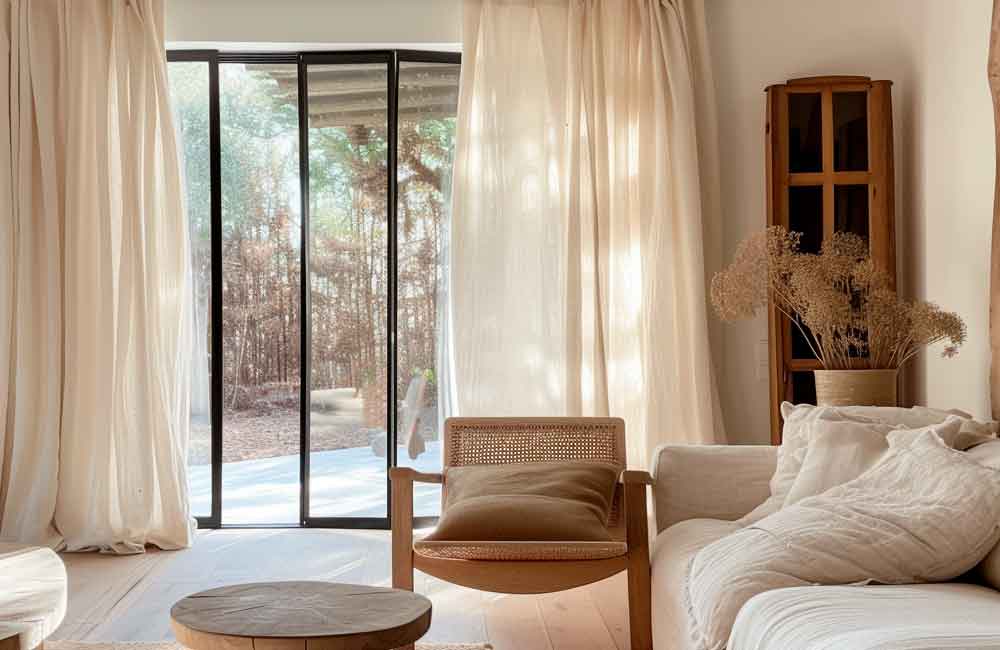Measuring & Fitting Included
Get an immediate price using our online estimator
Years’ of experience
Daytime, evening & weekend appointments
Call to speak to our call centre
The concept of slow living has gained significant attention in recent years as people seek to disconnect from the fast-paced and hectic nature of modern life. Slow living promotes a more intentional and mindful approach to daily routines, focusing on quality over quantity and finding joy in the present moment. This philosophy can be seamlessly integrated into interior design, creating spaces that evoke a sense of calm, tranquility, and well-being. In this article, we will explore the principles of slow living interior design and how you can incorporate them into your own home.
One of the key aspects of slow living interior design is creating a serene and peaceful environment. This can be achieved through various design elements and choices, such as:
Utilizing natural materials in your home not only adds warmth and authenticity but also contributes to a more sustainable and eco-friendly approach. Incorporate elements such as reclaimed wood, bamboo, linen, and organic textiles to bring a touch of nature indoors.
Opt for soft and soothing colour palettes that promote relaxation and harmony. Earth tones, pastels, and muted shades are perfect choices for slow living interior design. Avoid using bright or vibrant colours that may create a sense of restlessness.
Maximize the use of natural light in your space. Natural light not only enhances the overall aesthetic but also has a positive impact on our mood and well-being. Consider using sheer curtains or blinds that allow light to filter through while maintaining privacy.
Embrace minimalism and declutter your living spaces. A cluttered environment can lead to feelings of anxiety and overwhelm. Keep only the essentials, organize your belongings, and create designated storage areas to maintain a clean and uncluttered space.

Slow living interior design emphasizes comfort and cosiness. Focus on creating an inviting and cosy atmosphere by incorporating the following elements:
Invest in plush and comfortable furniture pieces that prioritize comfort without compromising on style. Oversized sofas, cosy armchairs, and soft cushions create a welcoming space for relaxation and unwinding.
Experiment with different textures to add depth and visual interest to your interiors. Incorporate layers of soft rugs, textured throws, and tactile fabrics to create a cosy and inviting atmosphere.
Pay attention to lighting choices to create a warm and soothing ambiance. Opt for soft, diffused lighting options such as floor lamps, table lamps, and dimmers. Avoid harsh and bright overhead lighting that can be overwhelming.
Bring nature indoors by incorporating plants and greenery into your space. Indoor plants not only enhance the aesthetic appeal but also improve air quality and promote a sense of tranquility. Choose low-maintenance plants that thrive indoors.
Slow living interior design encourages a mindful and sustainable approach to design choices. Consider the following:
Choose furniture and decor items made from sustainable materials, such as reclaimed wood, bamboo, or recycled materials. Support local artisans and businesses that prioritize ethical and eco-friendly practices.
Explore the world of vintage and second-hand furniture and decor. Not only does this add character to your space, but it also reduces waste and promotes a more sustainable lifestyle.
Emphasize quality over quantity when selecting furniture and decor pieces for your home. Invest in well-crafted and durable items that will stand the test of time, rather than constantly replacing disposable and mass-produced items.
Get creative with repurposing and upcycling old items. Give new life to vintage furniture or transform everyday objects into unique decor pieces. This not only reduces waste but also adds a personal touch to your interiors.
In conclusion, slow living interior design offers a holistic approach to creating spaces that promote relaxation, well-being, and mindfulness. By incorporating natural elements, embracing cosiness, and prioritizing sustainability, you can transform your home into a sanctuary of tranquility, allowing you to unwind and reconnect with what truly matters. Embrace the principles of slow living interior design and create a space that nurtures your soul and supports your well-being.

Q1: What is slow living interior design?
Slow living interior design is a concept that promotes a more intentional and mindful approach to daily routines by creating spaces that evoke a sense of calm, tranquility, and well-being. It focuses on quality over quantity and incorporates elements such as natural materials, soft colour palettes, ample natural light, and clutter-free spaces.
Q2: How can I create a serene environment in my home?
To create a serene environment in your home, you can incorporate various design elements and choices. Some suggestions include using natural materials like reclaimed wood and organic textiles, opting for soft and soothing colour palettes, maximizing natural light with sheer curtains or blinds, and embracing minimalism to maintain clutter-free spaces.
Q3: What are some ways to embrace cosiness and comfort in slow living interior design?
To embrace cosiness and comfort in slow living interior design, you can focus on incorporating elements such as soft furnishings like oversized sofas and cosy armchairs, layered textures with rugs and textured throws, ambient lighting with floor lamps and dimmers, and bringing in natural elements like indoor plants.
Q4: How can I practice mindful and sustainable design in slow living interior design?
To practice mindful and sustainable design in slow living interior design, you can choose furniture and decor made from ethical and eco-friendly materials, explore vintage and second-hand finds to reduce waste, prioritize quality over quantity when selecting items, and get creative with repurposing and upcycling old items to add a personal touch to your interiors.

With a keen eye for design Natalie is the Blinds Design Specialist at Custom Fitted Blinds. Dedicated to creating personalised solutions, she transforms spaces with creativity and expertise.
© 2024 All rights reserved
Made with ❤ with Elementor